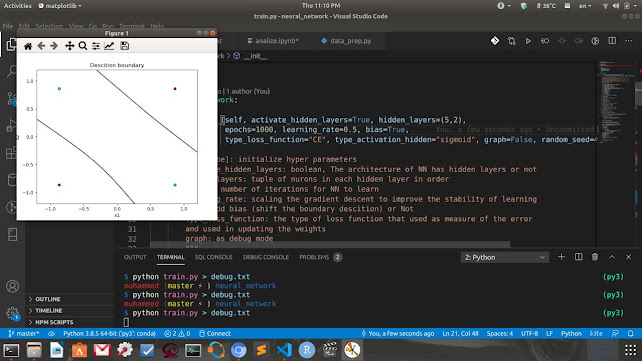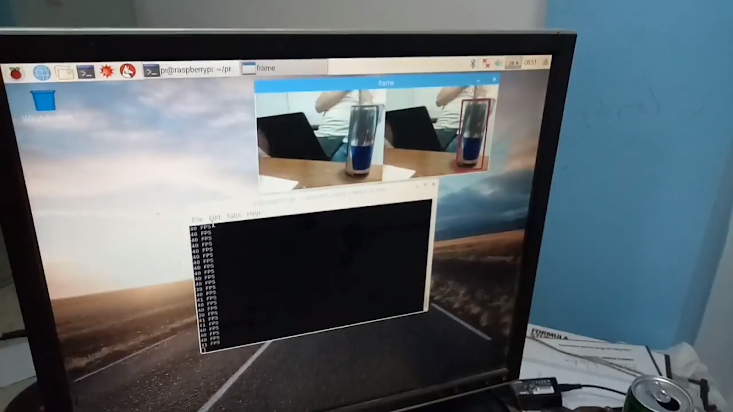In 2020
Image classification for flowers (102 classes of flowers)
Using Pytorch in deep learning and CUDA
Using Pytorch in deep learning and CUDA
Here is the code
In 2020
Path planning using many algorithms:1_ breadth-first-search: for unweighted edges
2_ depth-first-search: It has some advantages over other algorithms in rare cases like storage and completeness if there are infinity children for the node.
3_Dijkstra's: It has the advantage of finding the shortest path between the start node and all other nodes, not only the goal node
4_ cheapest-first-search: it has an advantage over Dijkstra's in-memory storage but has uniform contours.
5_ gready_best_search_algorithm: by using a heuristic, it focuses on the goal so, it is faster than cheapest-first-search
but has drawbacks if there are obstacles, it doesn't guarantee to find the shortest path.
6_ finally A*: it combines between efficiency and finding the optimal solution but depends on choosing admissible(for finding an optimal solution) and (consistent for efficiency optional) heuristic
Thanks for
professor: Peter Norvig, for his good lectures about problem-solving-technology.
professor: Sebastian Thrun for his support.
Have fun!
note:
Using a Fibonacci priority queue, it has a better performance
than any priority queue like binary because of insertion
https://lnkd.in/dQe2CRC
Have fun!
note:
Using a Fibonacci priority queue, it has a better performance
than any priority queue like binary because of insertion
https://lnkd.in/dQe2CRC
In 2020
The purpose of this project
is to implement the magical NN from scratch by applying some math like linear algebra, calculus, and probabilities. And understanding the hyperparameters and implementing various techniques to improve the learning process.
Inventory:
1_Customize n hidden layers as you want to make it deep
2_Customize the number of neurons in each hidden layer
3_Flexibility Adding bias or not for all layers
4_Early stopping algorithm
5_Flexibility adding drop out for the layers
6_regularization L1 / regularization L2
7_Flavors gradient descent:
Batch gradient descent
Stochastic gradient descent
Mini batch gradient descent
8_Implement common activation function: Sigmoid / Softmax / Tanh / Relu / Elu
9_Add Momentum
https://lnkd.in/dyfJDMB
Have fun ^_^
is to implement the magical NN from scratch by applying some math like linear algebra, calculus, and probabilities. And understanding the hyperparameters and implementing various techniques to improve the learning process.
Inventory:
1_Customize n hidden layers as you want to make it deep
2_Customize the number of neurons in each hidden layer
3_Flexibility Adding bias or not for all layers
4_Early stopping algorithm
5_Flexibility adding drop out for the layers
6_regularization L1 / regularization L2
7_Flavors gradient descent:
Batch gradient descent
Stochastic gradient descent
Mini batch gradient descent
8_Implement common activation function: Sigmoid / Softmax / Tanh / Relu / Elu
9_Add Momentum
https://lnkd.in/dyfJDMB
Have fun ^_^
In 2018
The robot recognizes the object and recognizes human to interact with.
Features In this project:
1_ We made an object recognition.
2_ We made robust facial recognition.
2_ We made robust facial recognition.
3_ We made mapping from 2d camera into 3d world to transfer information from computer vision into the physical robot (arm or mobile robot).
4_ We made a kinematics robot for 6 DOF arm robot.
5_ We deploy the software on raspberry pi and AVR microcontroller unit.
6_ We made the mechanism for the robot.
7_ We made the electric circuits
https://www.youtube.com/watch?v=jk9X27XQk5k&list=PLVU_mZCkhn-aExBlBMJAuHEcXeJb2NYT8&index=5&pp=sAQB&ab_channel=MuhammedEl-Yamani
In 2018
We participated in the maker fair with this robot with the FAB LAB.
Objectives:
The robot recognizes an object by RGB camera and calculates the distance to the object to grab
Features:
1_ computer vision and image processing to recognize the object
to be robust and invariant to size, rotation
2_ get some useful physical geometry from the RGB camera
like distance, and mapping cartesian from the camera to the world cartesian, and calculate the orientation of the object.
3_kinematics of mobile and arm robot
4_deploy control software into AVR microcontroller.
https://www.youtube.com/watch?v=OPGJl5cpCm4&list=PLVU_mZCkhn-aExBlBMJAuHEcXeJb2NYT8&index=9&ab_channel=MuhammedEl-Yamani
Robust facial recognition in real-time
using many algorithms and many papers
In 2018
https://www.youtube.com/watch?v=Y0jdRN0FLig&list=PLVU_mZCkhn-aExBlBMJAuHEcXeJb2NYT8&index=7&ab_channel=MuhammedEl-Yamani
https://www.youtube.com/watch?v=3171of1YpuE&list=PLVU_mZCkhn-aExBlBMJAuHEcXeJb2NYT8&index=1&ab_channel=MuhammedEl-Yamani





























